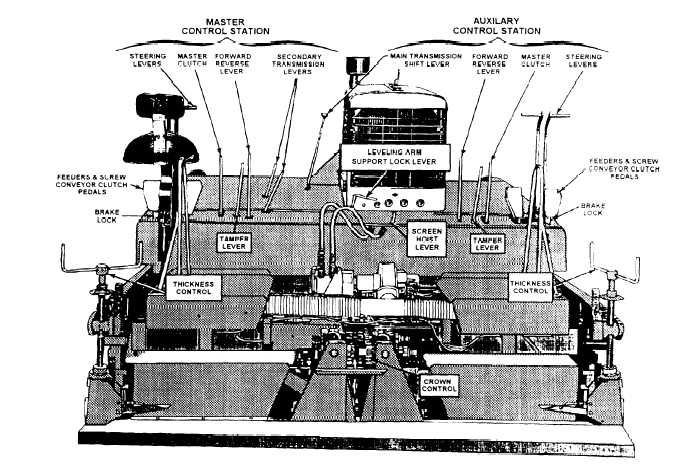Tractor Unit (Power Unit)
The tractor unit provides moving power for the
paver wheels or tracks and for all powered machinery
on the paver. The tractor unit includes the receiving
hopper, feed conveyor, flow control gates, distributing
augers (or spreading screws), power plant (engine),
transmissions, dual controls, and operator’s seat.
The tractor unit power plant (engine) propels the
paver, pulls the screed (leveling) unit, and provides
power to the other components through transmissions.
Hot mix is deposited in the hopper and is then carried
by the feed conveyor through the flow control gates to
the distributing augers (spreading screws). The augers
distribute the mix evenly across the full width of the
paver, thus providing uniform placement of the mix onto
the roadway surface. These operations are controlled
by the paver operator by means of dual controls within
easy reach of the operator’s seat. Figure 16-40 shows
the operating controls of one type of finisher used in the
NCF.
To ensure the paver functions properly, you should
inspect the paver before commencement of paving.
Below are some of the compments you should check.
PAVER TIRES OR TRACKS.— When the paver
is equipped with pneumatic tires, tire condition and air
pressure must be checked. It is particularly important
for the pressure to be the same in the tires on both sides
of the paver.
When the paver moves on tracks
(crawlers), the tracks should be checked to be certain
they are snug but not tight, and the drive sprockets
should be checked for excessive wear. Low tire pressure
or loose tracks can cause unnecessary movement of the
paver, which is transmitted to the screed unit, resulting
in an uneven pavement surface. There should be no
buildup of material on the tires or on the tracks.
GOVERNORS.— The governor on the engine
must also be checked to be sure that there is no periodic
surge in the engine rpm.
When the governor is not
working properly, there can be a lag in power when the
engine is loaded (strained). Such a lag causes temporary
failure of the vibrators or tamping bars in the screed unit,
resulting in a stretch of pavement that is less dense or
Figure 16-40.-Operating controls, Barber-Greene model SA-35 finisher.
16-36

